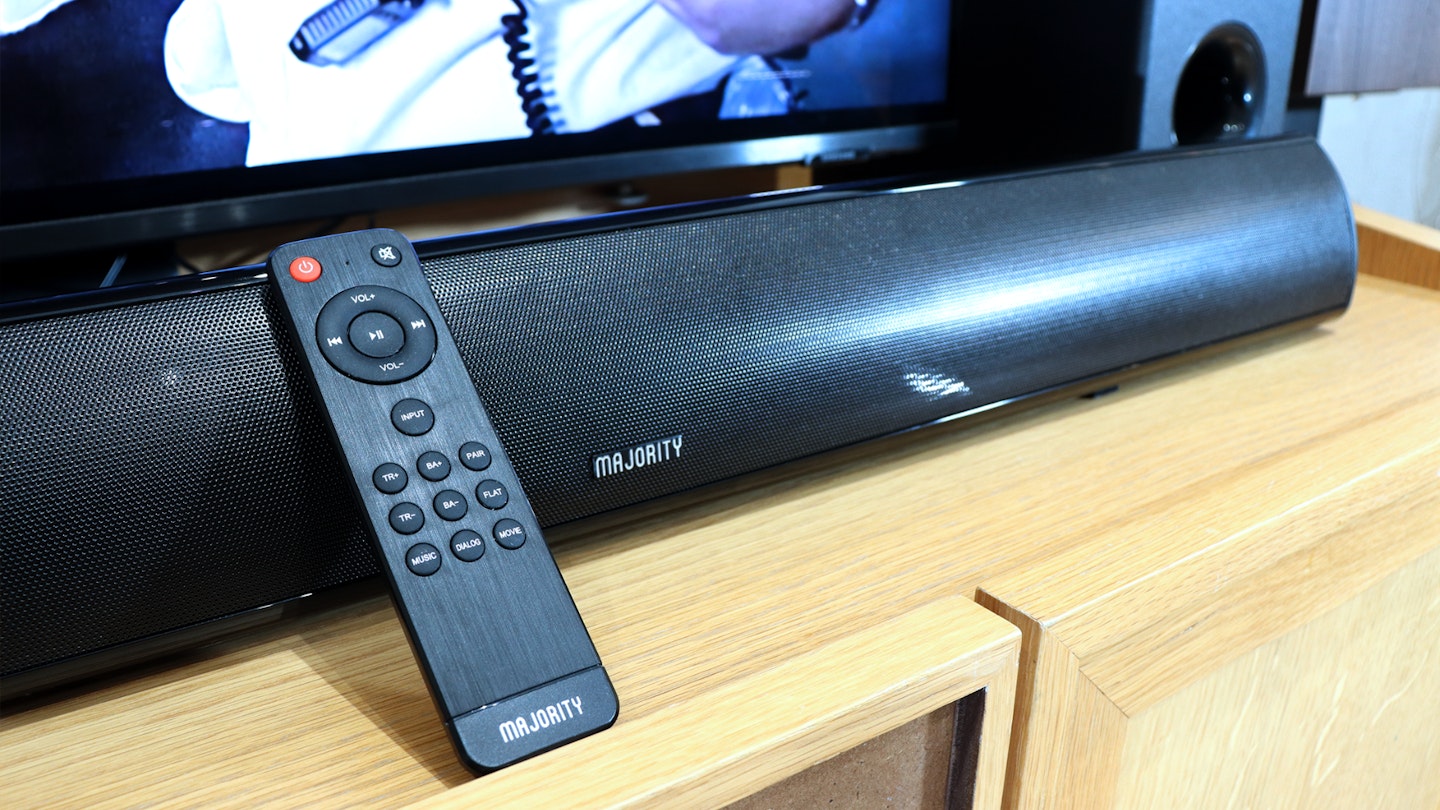If you’re on the lookout for reliable audio tech on a budget, you'll probably be familiar with Majority. The ever-expanding product range from the Cambridge-based audio company currently spans speakers and streaming audio players through to complete systems. Although mainly aimed at those who just want music, radio and podcasts, it also includes some excellent soundbars. The Majority Teton Plus Soundbar with Wireless Subwoofer is just one of over a dozen soundbar-based products designed to bring quality audio to your TV.
The Teton Plus sit right in the middle of the Majority soundbar range in terms of price. The lineup starts with the compact Bowfell soundbar and goes up to the Sierra Plus Dolby Atmos package. So, the Teton is clearly positioned as the more affordable mid-low budget option. This sizable soundbar is looking to bring big sound to those who don’t want a more expensive and complicated option.
And that’s a tall order - especially for a large soundbar that comes with a Bluetooth subwoofer. Can it outshine a half-decent TV for well-rounded sound and better bass? What’s The Best audio expert, Chris Duffill, has unplugged his AV amp, hooked up the Teton Plus and gone square-eyed watching his 4K TV. So, as an audio package that comes in under £100, did the Majority Teton Plus Soundbar deliver sound entertainment? Or was it all looks and no substance?
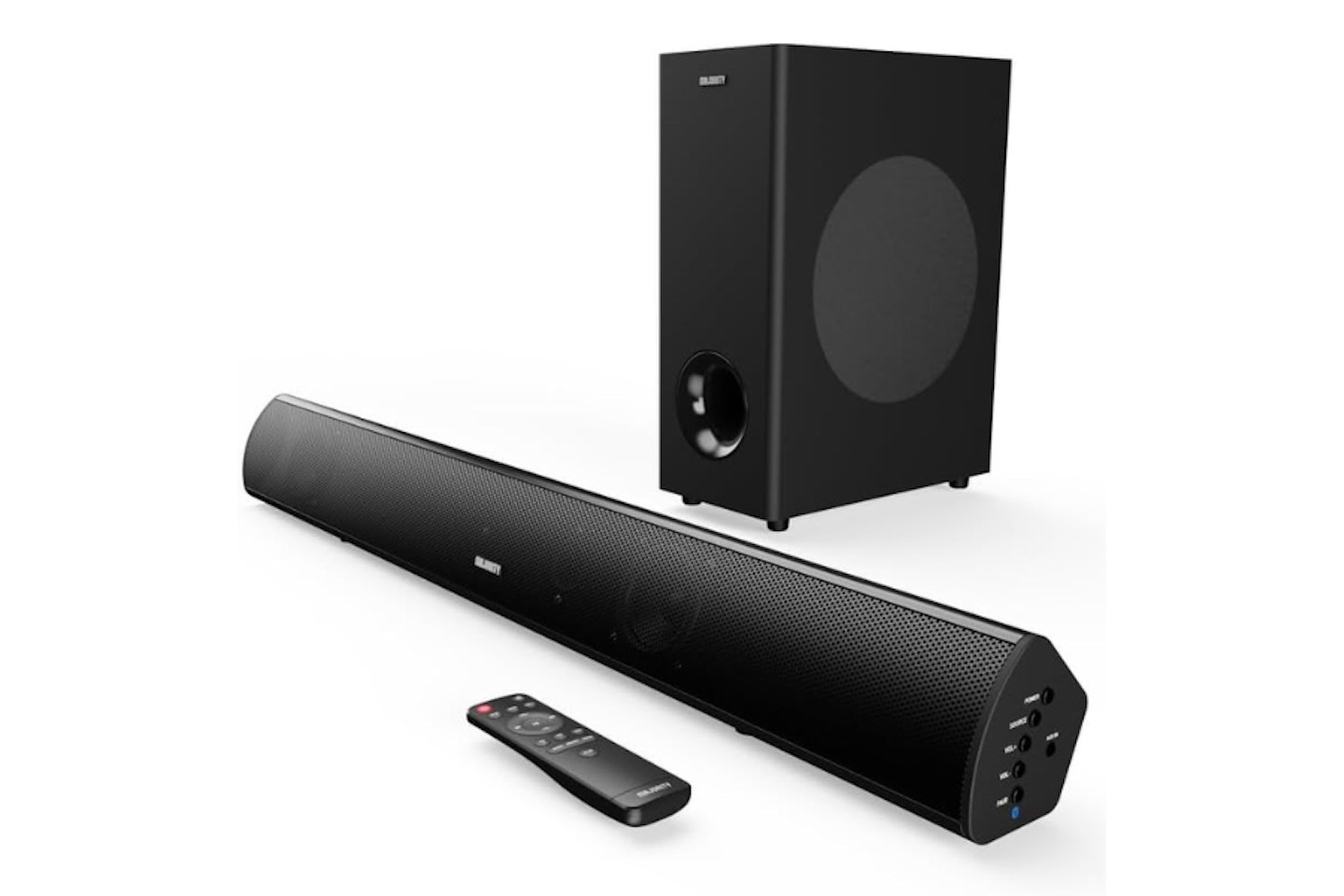
Pros
- Big sound from a surprisingly light but sizable soundbar - looks the part too
- EQ presets and the ability to tweak treble and bass from the remote
- HDMI ARC connection means the TV's own volume control will control the Teton Plus instead
- The wireless subwoofer means less cable clutter and it pairs instantly
- Excellent well-rounded bass that can get loud but doesn't break
- Clear dialogue and a very well-balanced soundstage
Cons
- Has a slightly lightweight build in places
- Max volume is loud but not to the extreme - for sheer power look at a home cinema amp
- Stereo only - doesn't support e-ARC or deliver advanced surround sound formats

While I'm unboxing…
Firstly, a bit of an admission. Being a fan of dedicated home cinema systems, I’ve always been a little dubious when it comes to the big claims made by most soundbars - including the Majority Teton Plus. Although there have been stunning developments in virtual surround sound, for me nothing really competes with separate speakers placed around the room. But, that’s not the point here. The Teton Plus, like all soundbar systems, isn’t for those who want (or need) a sprawling home cinema speaker setup. And, quite often, that includes me.
Sometimes you don’t want to fire up an amp and other AV separates just to watch a bit of evening TV or even the odd movie (sorry, home cinema purists… but sometimes simple will do just fine). So, it’s with this in mind that I started to unpack the Teton Plus.
The unboxing stage doesn't normally make it into my reviews, but this one was a little different. It comes in a slightly unwieldy L-shaped box. Despite being an efficient fit for the contents, this turned out to be quite important. Not because it was difficult (it wasn’t), but because it ended up signposting an issue that's best described as 'When slightly inadequate packaging meets lightweight speaker grille'.
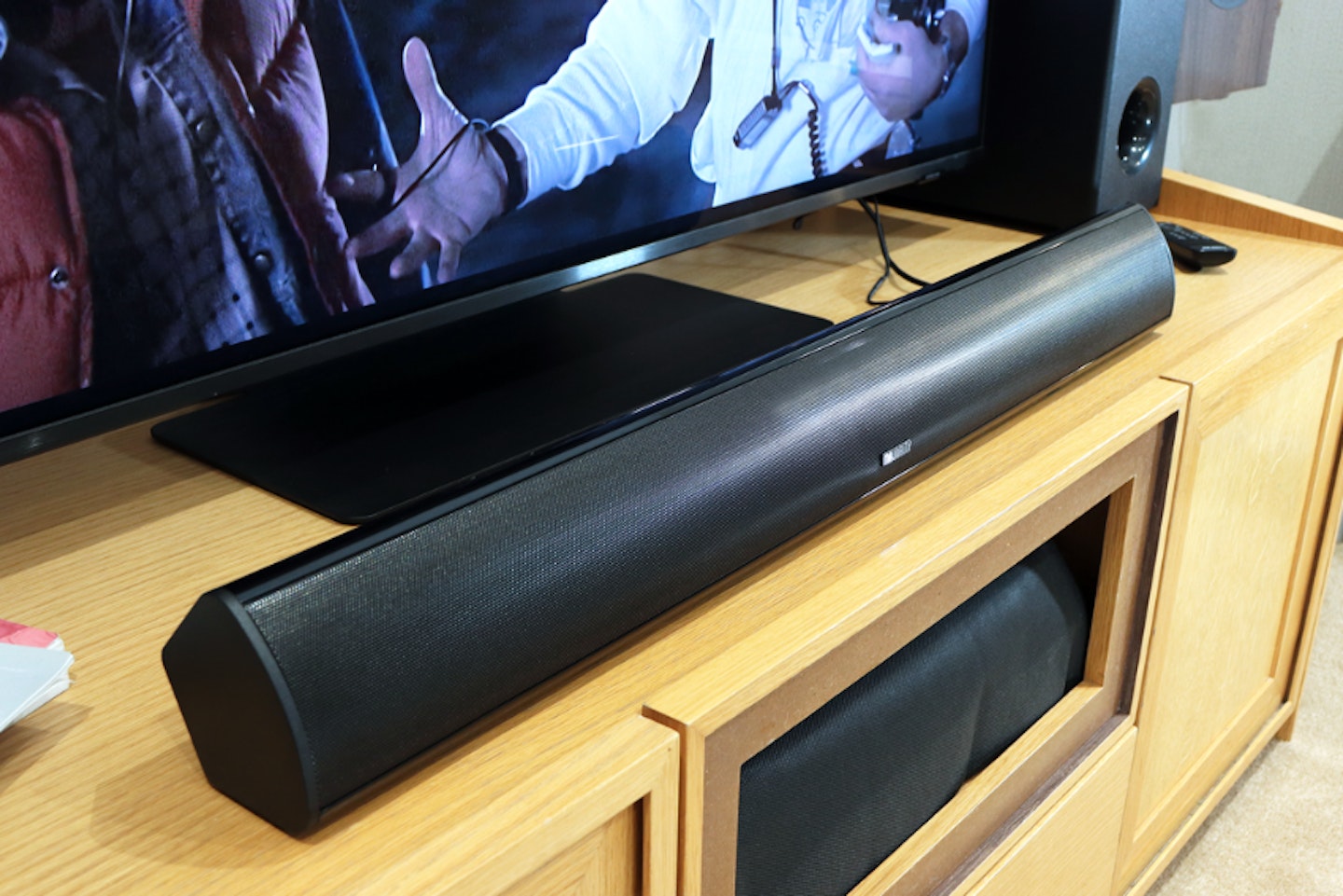
Setting up
Soundbar setup
I removed the subwoofer to get to the soundbar, the latter is cradled (but not encased) in styrene. The box is a snug fit. You'll need to use one hand on the soundbar and the other to brace the box. Once removed from the styrene, there are thin foam strips and a cover in place to keep everything shiny, new and fingerprint-free. I unwrapped it, placed the soundbar on my AV unit and immediately realised my mistake…
Soundbar design and build
The black aluminium front grille is sturdy enough to withstand normal handling - but, as it turns out, not as you unpack it. I’d placed a minor but noticeable indentation right in the middle of it. And that’s simply because you can’t see what you’re doing when it’s still wedged inside the box. The styrene packaging of the soundbar is only partial, the rest being those thin foam sheets to keep it in place. So, I’d used a tad too much pressure in just the wrong place.
Much like other smaller Majority soundbars, the overall design and build approach is the same. In many ways, the Teton Plus is like a scaled-up Bowfell. But, whereas the Bowfell (which I also own) is small enough to withstand handling, the same build on a larger version is far less forgiving. That’s partly down to the larger contour of the front grille on the Teton Plus.
All that said, this is most certainly not a flimsy bit of kit. It’s well-built and engineered (if lightweight) for its size. I’d simply been unlucky enough to find its Achilles heel as I removed it from the box. Thankfully, I was able to put the grille back into shape.
It does look the part though, and I appreciate the curved profile. My TV is on a fairly low AV unit rather than on a TV wall mount at the moment. The top happens to line up perfectly with the bezel on my Samsung QN90A Neo QLED TV. I suspect that'll be true of most other models too. So, despite its fairly chunky profile, the Teton Plus doesn’t obscure my screen.
Soundbar weight and sound isolation
At close to a metre long, soundbars like this are normally quite weighty. The soundbar is surprisingly light at only around 1.5 kg. But, the weight of a system is less of a signpost to the sound quality these days; so, I ignored that for now.
Thankfully, the back of the soundbar does have some fairly sizable (removable) brackets for wall-mounting. So, those will improve sound isolation when I eventually put my TV back on the wall. But for now, given how light this soundbar is, I did have some reservations over how well the rubber feet would isolate the bar from the AV unit.
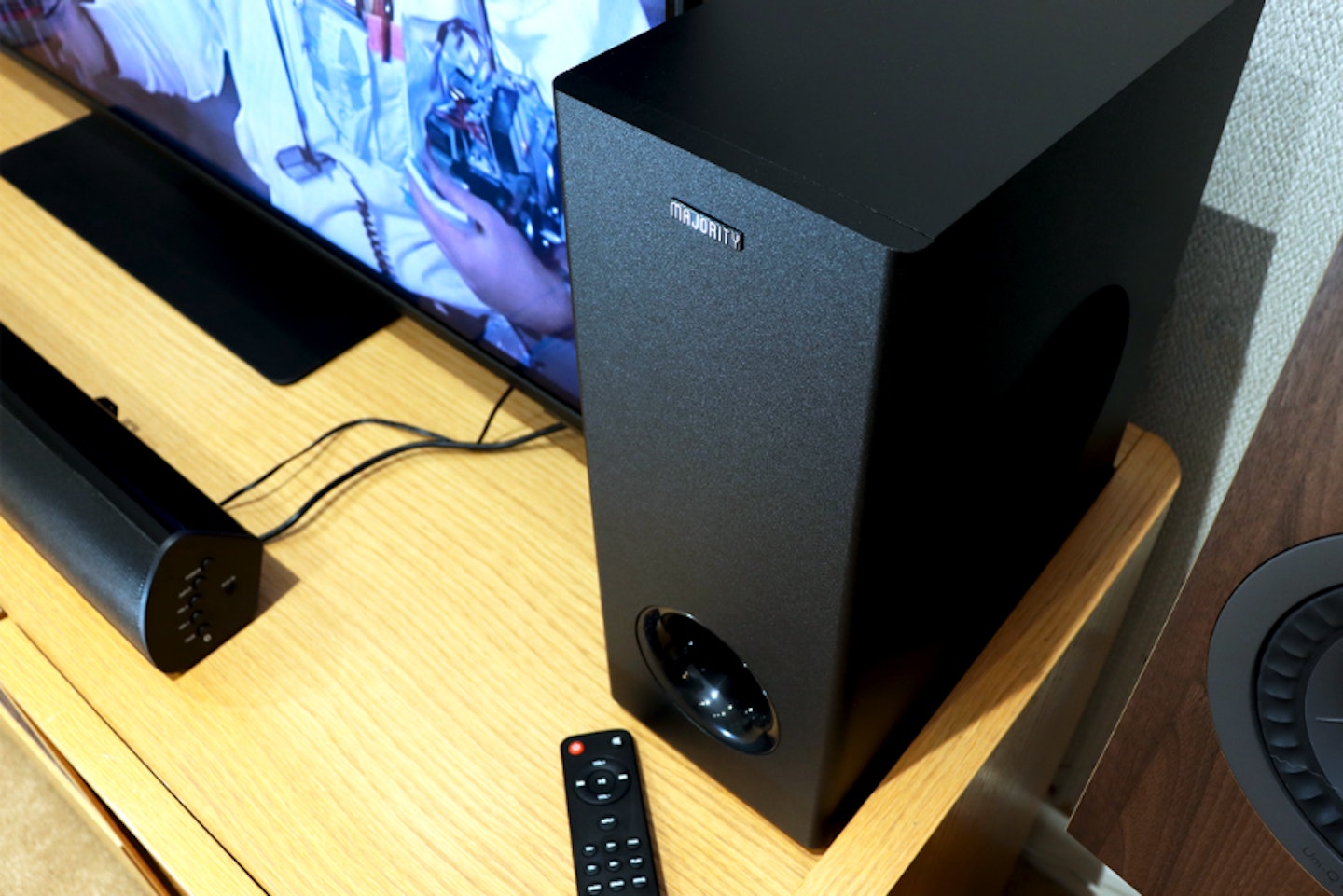
Subwoofer setup and build
At around the size of a small but slightly chunky briefcase, the sub feels solid. It has a bit of heft to it. Majority has resisted the trend of making the cabinet a large cube - meaning it can be placed almost anywhere. The company has clearly understood its market here. This sub is designed to slot right in next to your existing setup without the need to move furniture around. It recommends placing the sub as close to the soundbar as possible, and that makes a lot of sense; This isn’t an uber-powerful home cinema setup in compact form - it’s a 2.1 soundbar and modest subwoofer. So, the last thing you’ll want is disassociated bass coming from the back of your room.
Setup was automatic. Having powered both the soundbar and the sub, the subwoofer pair light only took a moment to go solid. After that, there was nothing else to do other than start watching TV.
Design and build-wise, there’s not too much to comment on here. It’s a sturdy box with a front-facing bass port and a side-mounted cone. And there are no independent volume or crossover dials that you might find on high-end subs for connection to amplifiers. Other than the fact that it auto-pairs with the soundbar via Bluetooth, it’s a low-frills sub that will fit every room.
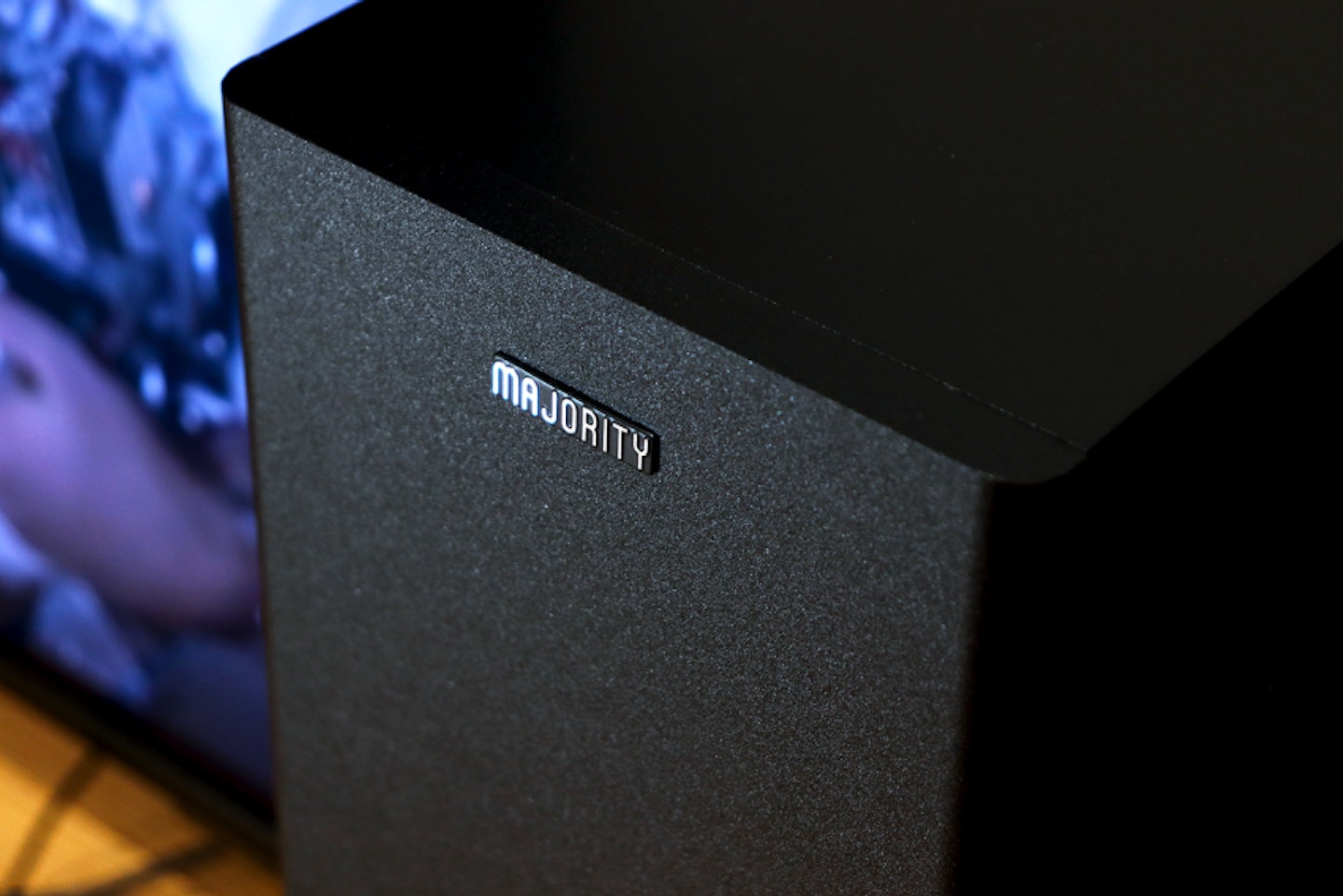
Soundbar connections
Bluetooth
The Teton Plus soundbar has Bluetooth - which we already know as the subwoofer uses it to connect to the bar wirelessly. But, one nice touch is that it’ll support another Bluetooth connection for streaming audio input. If you don’t already have a Bluetooth smart speaker for music, you could pair this with your phone or tablet and enjoy enhanced sound and volume.
It’s worth remembering that, much like all soundbars, there’s no reason why this has to be used in conjunction with a TV or PC or anything else that has a screen. Majority’s instruction booklet is very generalised when it comes to what can be connected to the Teton Plus. Other than placing it alongside TVs, Majority see this as a multipurpose speaker system for devices things like smartphones and portable audio players if you need it to be.
HDMI ARC
As for my setup, I opted for the HDMI ARC connection, as this makes the most sense for my needs. For those who aren’t familiar with this, ARC stands for Audio Return Channel - it allows you to use an ARC-enabled HDMI port on your TV to send the audio of whatever you're watching to an audio system. My TV supports ARC and e-ARC; The latter is the enhanced version of ARC that can pass through Dolby Atmos and the like. But the Teton itself doesn’t support that. Understandable, as it’s a 2.1 speaker system.
For me, ARC also means that controlling the volume via Alexa and the Samsung remote (and app) also controls the Teton Plus. It also turns on when the TV is switched on. Given that this is probably the most hassle-free and convenient setup for many, I think the omission of a short HDMI cable from the Teton Plus is a little bit of an oversight. I’d rather have seen one of those than the 3.5mm audio and RCA cables they included.
One small-ish hiccup here is the compatibility with certain brands and models of TV with audio formatting. To Majority’s credit, there’s a sizable sticker on the soundbar itself that tells you to adjust the HMDI ARC audio format of your TV to PCM if you have no sound output. That was the case for me - easily fixed by setting the Samsung audio mode away from ‘Auto’ to PCM.
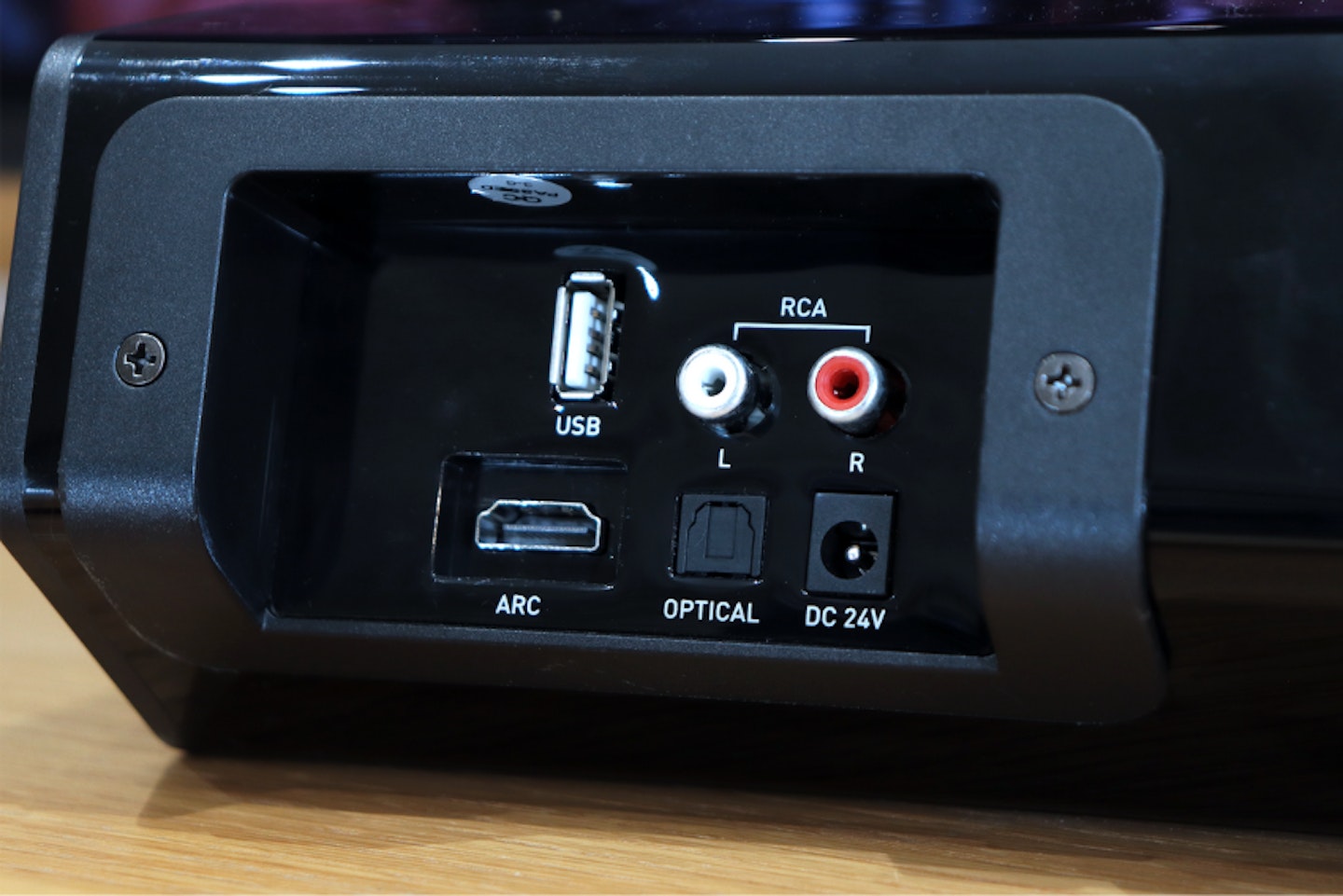
Optical
Optical connectivity is a good option for TVs without HDMI ARC as you still get digital audio, but is also ideal for someone with more than one TV or display. For instance, if your main TV is connected via HDMI, you could easily connect another device (such as a PC with optical out, or a CD player) to the Teton for a little bit more flexibility when it comes to enjoying better digital sound.
Audio jack and phono (RCA)
The 3.5mm audio jack AUX connection on the side is handy too. If you have one of the older iPods or iPhones around - not to mention a slew of other music players - you can hook it right up to the Teton Plus for instant amplification. The RCA (phono) option though is a little redundant for me. In terms of TVs, those that don't have HDMI ARC are fairly likely to have a digital optical output. Even if you have both optical and RCA, the former is obviously the better choice.
USB
This is welcome, but does seem a bit superfluous. I can’t imagine anyone actually plugging a USB flash drive into the Teton to play their audio files; Not when there’s Bluetooth on offer (or even casting your audio to a TV with the Teton Plus attached).
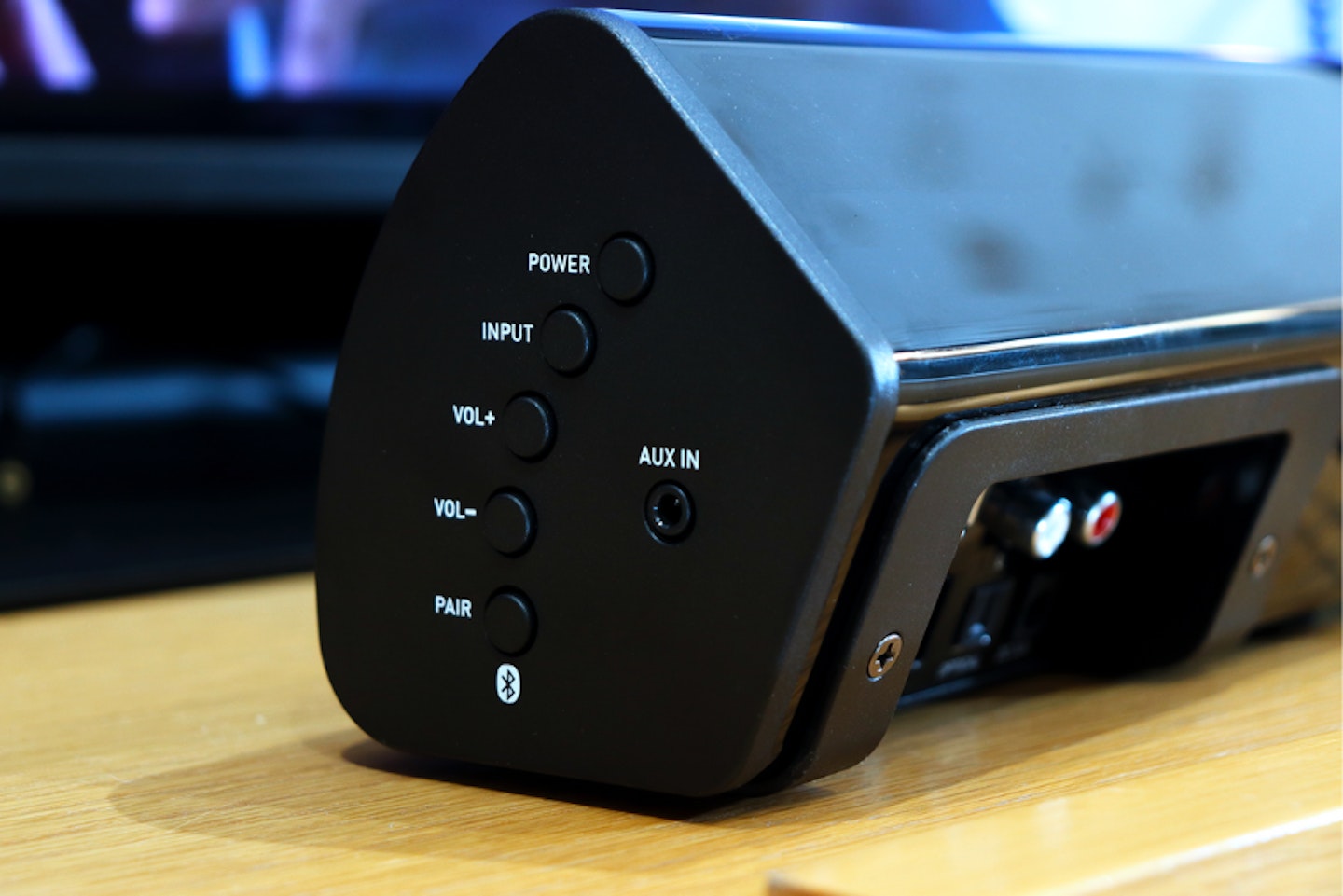
Controls and modes
There’s not much going on here - and that’s a plus. For me, the whole proposition of a soundbar-based solution is to keep things simple. That means being able to sit down, grab a remote (or reach for the soundbar itself if you’re next to it) and change the volume. Switching between sources is simple too, given that you only have three or four to choose from.
Main controls
Thankfully, the main buttons on the soundbar aren't in plain sight - instead tucked away on the right side. The button layout is nicely arranged and well-spaced too, so using them in a darkened room quickly becomes intuitive. That said, they're really only ever going to be used as a backup in case you lose the remote or are stuck for fresh batteries. The Bluetooth pairing button is the handiest one of the lot. There are also more functions on the remote than on the unit itself, and that's where this system really comes into its own.
Remote control
A refreshingly uncomplicated device for anyone who has a growing collection of multi-function remotes, the Teton Plus' control is a good size with quick access to all key functions. It makes switching between the three preset sound modes (Music, Dialogue and Movies) nice and easy. I particularly like the extra buttons for tweaking the bass and treble. As it turned out, this was essential in getting the bass level right for the sub - more on that later.

Performance and sound
Let’s start with the stats. This is a 2.1 audio system - meaning it has two front-facing speakers (housed at each end of the soundbar) plus the subwoofer. Naturally, the sub handles the low end via its 5.25” wide driver for a more resonant bass response. Collectively, there are 180 watts to play with, which is more than decent for a soundbar.
Some other brands should definitely pay attention to the Teton Plus' simple and unobtrusive way of displaying the input selection. There’s a status LED behind the grille in the top-right corner - it changes colour depending on the source you’ve selected. I was also relieved to see that the system, when connected via HDMI ARC, will power up and enter this mode as the TV is powered on.
Connected this way, volume commands using the TV’s original remote (or connected app) are relayed to the Teton. That makes for great flexibility if you’re sick of juggling remotes. It should be noted though - unlike some TVs that support the combination of internal speakers and an external soundbar (such as Samsung’s Q-Symphony), the Teton isn’t compatible with this feature.
As for those extra buttons on the remote to alter the bass and treble (plus those three EQ presets), they turned out to be the ones I used the most during testing. And I’ll explain why.
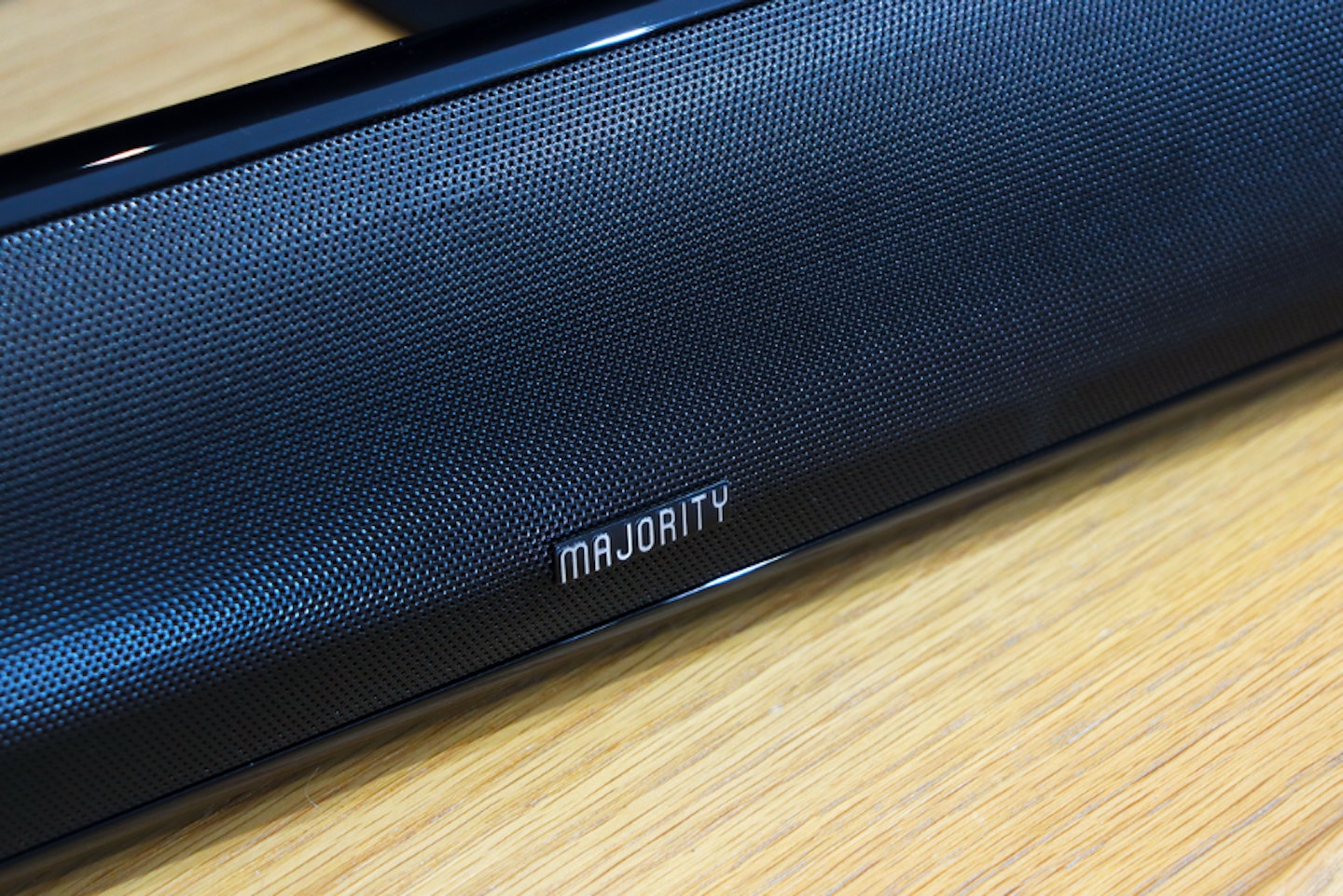
Streaming apps
I set out to stream some top-quality TV and started with the infected fungal-zombie smash The Last Of Us from Amazon Prime Video. Prime, like many streaming TV subscription services, uses an adaptive bitrate technology to optimise the quality to suit the available connection. It'll give you 5.1 surround sound and Dolby Atmos for content that has it. Here though, the Teton is just going to give you what it can - 2.1 sound. But, I did find the audio to be well-balanced with clear dialogue under all EQ profiles.
I tested shows, videos and movies - from apps like YouTube, to top streamers including Netflix and Disney+. My experience of using the Teton Plus was very similar across all of them. After all, this system is simply taking a digital signal and amplifying it; and without any of the complex options and more that you’d get with a full AV amp and surround speakers. And thankfully the default sound of the system is balanced, wide and reasonably neutral.
I did find myself reaching for the bass adjustment quite a bit with less professional content, such as some YouTube channels. The Teton Plus subwoofer is totally unforgiving with overcooked audio though. Even with some TV shows, such as Dexter: New Blood and Star Trek Strange New Worlds, there were moments of earth-shattering bass (in Movie Mode) that have clearly been mixed to suit more capable audio systems.
That said, without the Teton, my Samsung QN90A (a 50-inch 4K TV) would definitely have given me hugely broken bass. In that regard, the Teton is a completely brilliant upgrade to my TV. Those bass-heavy moments were easily tweaked, sometimes by switching the mode to dialogue (which is actually very well balanced for lots of content) or the Flat option. All that said, by the end of my testing I seemed to have hit a happy medium with this - I now have it in Movie Mode with the bass set just right for 95% of the shows and movies I end up watching.
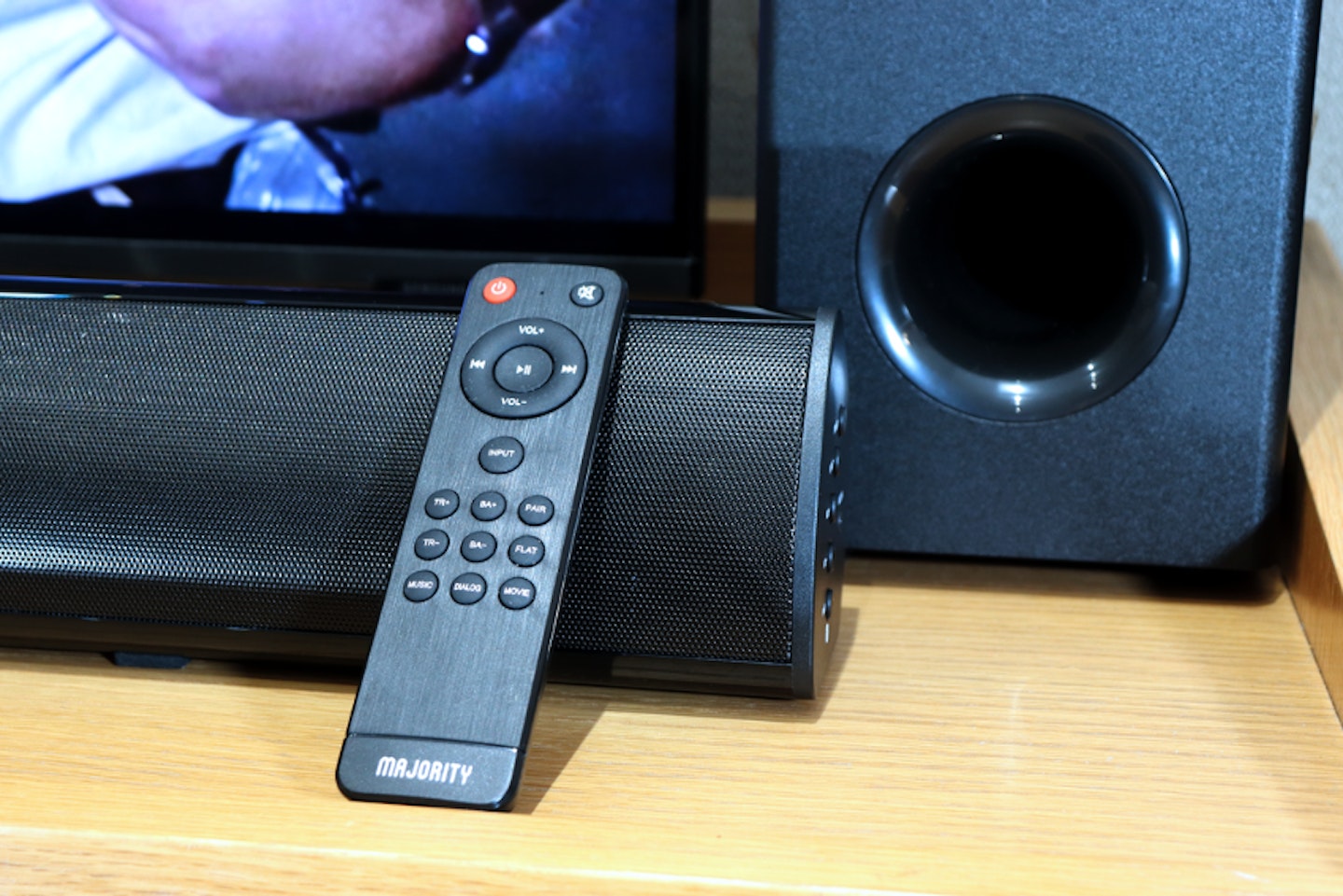
Playing movies locally
The Plex app can stream uncompressed video over a local network. And my BluRay player is there for direct playback. I wanted to see how the Teton Plus would handle various content. So, I threw Back To The Future into the BluRay - really, just to hear a DeLorean get up to 88 through the Teton; And later hunted down my copy of Blade Runner via Plex.
Obviously, it wasn’t possible to keep the advanced audio formats like Dolby Atmos or 7.1 surround as there’s no decoder in the Teton Plus for those. But, given that both the Plex app and BluRay output are effectively downmixed, the audio quality from the soundbar was almost identical across sources; Except for the incoming volume level which varies between them.
The BluRay line-level was loud enough to push the soundbar and sub slightly beyond a comfortably loud volume. But Plex (and possibly other apps) is notorious for having a lower line-level than most. For these, I had to have the Teton on max volume to reach a loud(ish) level. In fairness, this is a combination of the limitations of both Plex and the soundbar - but it’s the Plex app that needs future improvement here.
But back to those movies. Deckard’s gun in the Zhora sequence of Blade Runner was a real blast through the Teton Plus. It’s exactly that sort of infrequent 'boom' moment that shows the subwoofer at its best - adding extra gravity to those scenes. The same goes for Doc Brown’s trial run of the DMC-12 in the Twin Pines Mall parking lot. With the Teton Plus in Movie Mode and the bass tweaked down a tad, the movie really came to life with big-screen bass just where it was needed.
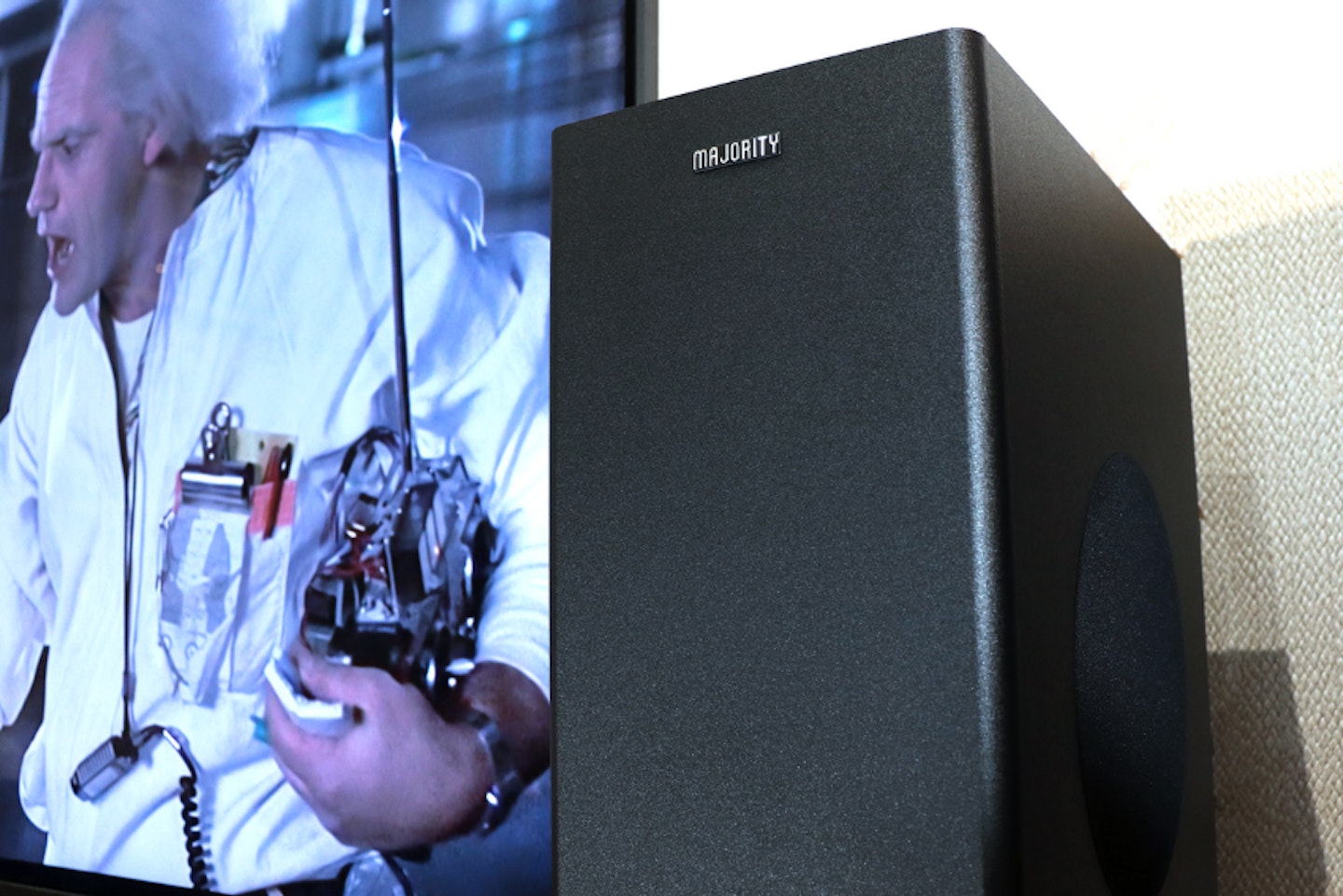
Bluetooth on iPad and iPhone
I tested both of these - starting with a blast of Ratt and AC/DC from Spotify Premium. As you’d expect from one of the best music streaming services, this was also a respectable experience. The Teton plus is not really tuned for music but does a decent job, with tight trebles and wide mids to cope with rock. It naturally has the bass to handle dance music and the like too. It’s not going to seriously compete with something like the Marshall Stanmore III that I reviewed for sheer musicality; But, if you don’t have one of those, the Teton Plus will do a great job at any impromptu house party.
I also wondered what watching YouTube and so on would be like on my iPad. It varied from app to app, but - as with many Bluetooth connections - there’s some audio lag involved. There’s rarely an audio delay setting for wireless audio connections in apps like these, unlike there is for TVs and AV amps.
3.5mm audio jack
There’s not much to report here - I connected an iPod Nano and, much like the other input sources, it sounded good enough for casual listening.

Any downsides?
The fact that the subwoofer doesn’t have any controls, including an independent volume control or crossover setting, means the bass response is a what-you-hear-is-what-you-get deal. And that's why the bass buttons on that remote are so important. So, even though there are three preset sound profiles to choose from, you’ll still find yourself reaching for the remote to tweak the bass now and then. It’s not exactly a hardship, though - and I’m thankful for quick access.
It’s loud, but not super-powerful. Even though it’s tempting to think of the Teton Plus Soundbar With Wireless Subwoofer as an affordable AV amplifier, it’s really more of a high-end TV speaker setup. It’s definitely loud enough for me for general viewing - and can even reach an uncomfortably high level with some content. But, if I find myself wanting more, I know I should really be listening on a proper home cinema system or even a full Dolby Atmos setup with ceiling speakers; or a soundbar package that costs at least double the price of the Teton.
And I can’t finish the downsides without mentioning the packaging and the middleweight grille build again. Given the price point and overall sound quality on offer here, I don’t think the build quality in itself is an issue - but it becomes one when combined with the packaging method.
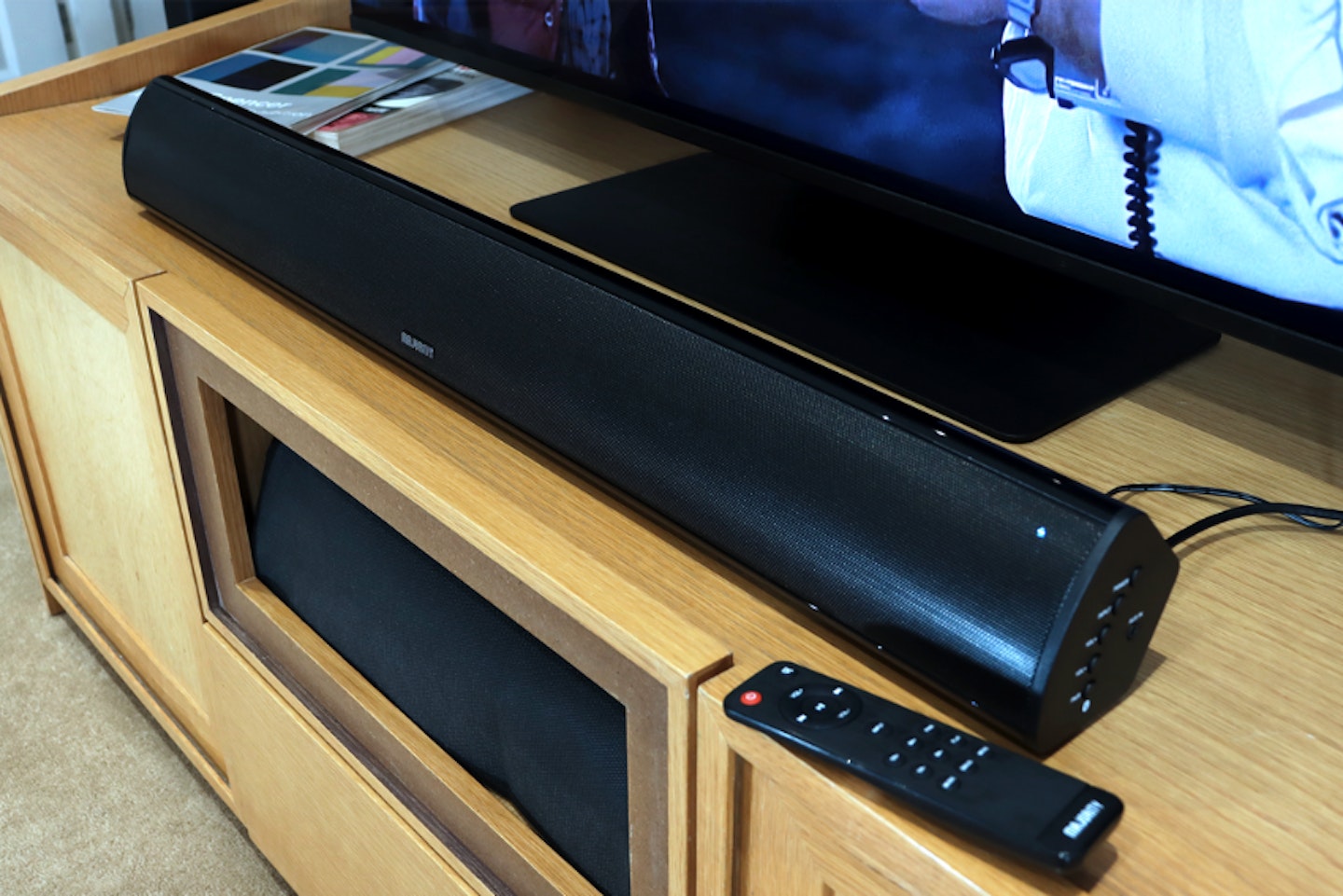
Price and competition
Soundbars are everywhere, but finding one at a lower price point while delivering a well-balanced sound is the hard part. If I had to choose a viable alternative I would pick the Polk Audio Signa S2 Soundbar. Like the Teton Plus, it also comes with a wireless subwoofer, Bluetooth, and HDMI ARC; but also has 5.1 Dolby Surround sound. You’ll pay quite a bit more for the privilege though, and not all users will need it.
Verdict
Majority is making a habit of coming out with kit that over-delivers (a little) for the price. Although the company produce Dolby Atmos soundbars with higher price-tags, this one knows just what it is - and what it isn’t. It isn’t a replacement for a budget home cinema AV amp setup from a decent brand. It also isn’t a particularly clever device. The soundbar doesn’t have seven or more speaker drivers in it and there’s no fancy DTS or Atmos decoding. It does one thing: 2.1 sound. And does it well.
If you think of the Majority Teton Plus with Wireless Soundbar as a serious upgrade to your TV speakers, you won’t be disappointed. It is aimed at casual watchers who wish they could ditch tinny sound and weak bass, especially when a decent movie comes on. Volume-wise, this will suit most people very well. But anyone who loves their movies loud and detailed via Dolby Atmos and the like should probably look at more expensive soundbars or dedicated home cinema systems.
All in all, this is a lot of power and flexibility for the money, and a welcome boost to all but the most expensive TVs in terms of overall sound quality and bass. The sound profile is well-balanced and very easy to tune to your taste thanks to those EQ settings. Hard not to recommend the Teton Plus, especially at this price.

Pros
- Big sound from a surprisingly light but sizable soundbar - looks the part too
- EQ presets and the ability to tweak treble and bass from the remote
- HDMI ARC connection means the TV's own volume control will control the Teton Plus instead
- The wireless subwoofer means less cable clutter and it pairs instantly
- Excellent well-rounded bass that can get loud but doesn't break
- Clear dialogue and a very well-balanced soundstage
Cons
- Has a slightly lightweight build in places
- Max volume is loud but not to the extreme - for sheer power look at a home cinema amp
- Stereo only - doesn't support e-ARC or deliver advanced surround sound formats
More items to consider
In What's The Best's review of the Denon DHT-S216 Soundbar, Will Lobley found it to be a very accomplished all-in-one soundbar with a great deal to offer. And that's certainly true when it comes to supporting a slightly more advanced audio format that the Teton Plus doesn't for surround effects - DTX Virtual: X. It's HDMI ARC and Bluetooth connectivity too.
Although the trade-off here is that this is (wired) subwoofer compatible, but doesn't come with one. What you lose in a sub you gain (a little ) in overall quality. That said considering it's still around £40 more expensive than the Teton Plus, the latter is still our choice for value for money.
Pros
- Versatile sound options with plenty of presets and tweaks
- DTS Virtual:X surround support
- Compatible with a wired subwoofer
- Six drivers for 2.1 sound
Cons
- Does not come with a sub
- Lags near start-up
- Not all modes are useful

This is a close contender for our recommendation for a complete soundbar and subwoofer system priced below the £200 mark. Although it costs more than the Teton Plus, the Polk Audio Signa does at least come with a wireless subwoofer and Bluetooth connectivity - but the thing that extra £80-ish buys you is 5.1 surround sound support - it's no DTS or Atmos though. Whether it looks better than the Teton is really a matter of opinion, but we think that the Signa S2 is only worth it if you want the 5.1 sound over the 2.1 of the Teton Plus. Given that both are basically comprised of a bar and a sub, whether the extra spend is justified is down to you.
Pros
- The compact wireless subwoofer fits anywhere
- 5.1 surround sound with Dolby Audio
- Remote control with plenty of options
- Low profile design will look great with any TV
- Bluetooth connectivity for easy and flexible use
Cons
- Some may find the looks a little plain
- Doesn't support Dolby Atmos
- No phono inputs
How this product was tested
The Majority Teton Plus Soundbar With Wireless Subwoofer was tested with a 50” Samsung QN90A Neo QLED TV. It was placed on a Blok AV unit in front of the TV, in a room around 12’ x 10’. The subwoofer was placed on the floor next to the unit and on the unit itself next to the soundbar. Sources tested included BluRay movies with DTS and Dolby sound, and standard stereo sound via Spotify and iPod Nano. The primary connection to the TV was via HDMI ARC.
Chris Duffill is a Tech Product Writer for What's The Best and Yours. His background includes writing, editorial, marketing, design, video production and photography.
He specialises in home entertainment and audiovisual tech, including speakers, amplifiers, turntables, streaming media players, and TVs. He is also one of our resident experts in computing (PCs, tablets, smartphones, smartwatches), DSLR photography and all kinds of digital cameras. He also writes about retro gaming, game consoles and various electronic gadgets. If it plugs in, lights up or makes a noise, he’ll write about it.
Subscribe to the What’s The Best Newsletter to keep up to date with more of the latest reviews and recommendations from the rest of the What’s The Best team.
